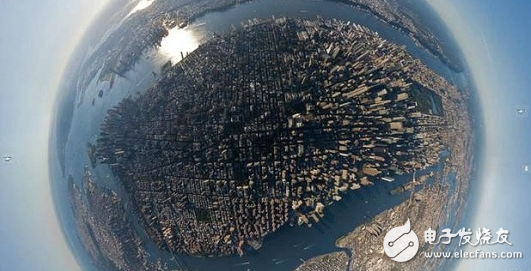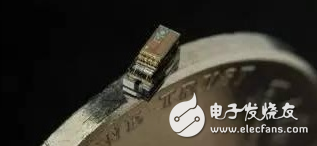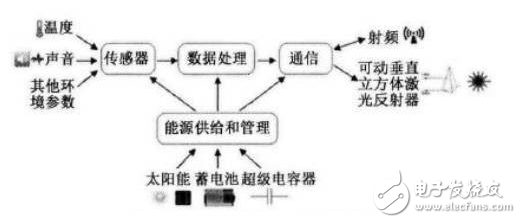The ultimate in the Internet of Things is that humans digitize most, if not all, of the physical world, and then collect, research, and even control. So the ultimate in the Internet of Things is a Google search that implements the physical world, and a model for innovation in other directions based on this model.

If you search the Internet for definitions, various encyclopedias will give the Internet of Things an extension of the Internet, enabling information exchange and communication between objects and objects. There is nothing wrong with saying this, but it is a technical answer. What is the practical significance of the Internet of Things for human beings?
The Internet of Things actually digitizes the physical world, and humans can communicate and collect data with those objects in the physical world. Of course, this is not to say that you said to the stone: "Is the stone I told you to dare to promise?" Then the stone replied "Dare!" Of course not this, but humans can use third-party software, systems, artificial intelligence, etc. To get this information, even the object "active" to provide this information.
Therefore, the ultimate goal of the Internet of Things is that human beings will digitize most, if not all, of the physical world, and then collect, research, and even control.
So the ultimate in the Internet of Things is a Google search that implements the physical world, and a model for innovation in other directions based on this model.
When it comes to this, you have to mention smart dust, which is almost the same as the concept proposed at the end of the last century.
A fine dust size of 1 cubic millimeter, a minimum of 1 dollar
Smart Dust is a miniature electromechanical sensor that transmits information wirelessly. It has a series of functional modules that we will see in our computers today, including power supplies, sensors, embedded processors, memory, communication components and software. How big is it? The current technology can achieve 1 cubic millimeter, which is about the size of a grain of sand. And the cost, currently the lowest can be achieved with a smart dust of 1 US dollar.

The future of smart dust can be suspended in the air within a few hours to collect, process, and transmit information. It can be used for weather monitoring and a variety of jobs that we can't imagine today.

It is very versatile and can detect many environmental parameters around it. It can change almost everything from light intensity to vibration energy. It can collect a large amount of data for calculation and then use the two-way wireless communication device to make this comprehensive information between the dust devices. Transfer.
Hundreds of micro-dust can also form a smart dust monitoring network that can self-organize, self-sustain, and work together to detect parameter variables in the surrounding environment (such as temperature and humidity). The data of all the secondary nodes of the intelligent dust network is not directly transmitted to the central aggregation node, but is transmitted to a master node through point-to-point. The data of different smart dusts is shared by the entire intelligent dust monitoring network.
Each intelligent micro-dust German-Chinese transceiver and embedded system constitutes a smart dust network based on local analysis and distributed control. The characteristic of this kind of network is that any two intelligent dusts are not physically connected, but can share the data on the smart dust. Information sharing can lead to a special type of smart dust collaboration that produces more information than a single mote.
Intelligent dust has four major features and four major features
1) Sensor module: As the core component of the whole intelligent dust system, the sensor is responsible for collecting information about the surrounding environment and converting it into an electrical signal. The information collected usually includes light, temperature, vibration, sound, humidity, gas, electromagnetic field and so on. As an ultra-compact product, a single dust can usually collect only a single type of data, and multiple dusts can work together to form a sensor network, and comprehensively detect a certain range of environmental conditions. The sensor module based on MEMS processing technology can basically meet the requirements of the intelligent intelligent dust system in addition to power consumption.
2) Micro-processing module: The part that is responsible for the data processing and operation of the whole system, including the analysis of the electrical signals transmitted by the sensor, and the transmission and reception of the data signals by the transceiver. The entire module is usually a microcontroller with a core, including a core processor, AD/DA converter, memory, and so on. At present, most foreign research adopts ARM architecture, and the power consumption and volume are in line with the requirements of intelligent dust system.
3) Communication module: When multiple dusts form a sensor network, the information exchange between the node and the node or the base station requires a communication module, which can be generally divided into RFID communication and laser communication according to the requirements of the transmission distance. RFID transmission distance is short, but it can realize all-round communication, and is not affected by small-sized obstacles. It is suitable for most short-distance applications. Laser communication transmission distance is particularly long, and power consumption is low. Generally, it is only used in ultra-far. In the data transmission of distance, Berkeley successfully tested the laser mote transmitting 20km.
4) Energy module: For the working hours of the intelligent dust system, the self-supply system is necessary. Therefore, the energy module is divided into two parts: energy harvesting and energy storage. The collection part usually adopts a solar thin film panel, and the storage part adopts a lithium battery of high energy density or a solid state battery with high integration and can be based on an on-chip process.
The size of the smart dust is usually on the order of cubic millimeters and can be used alone or in combination. It has 4 features:
1) Single or multiple detections of the surrounding environment: usually including sound, light, temperature, humidity, shock, electromagnetic fields, gases, and the like.
2) The size is on the order of cubic millimeters, the power consumption is extremely low, and it is easy to carry.
3) It has an energy collection and self-supply system.
4) Networking, which can realize point-to-point communication, and has real-time data transmission function to ensure real-time, fast and accurate information transmission.
working principle:

1 The sensor module collects surrounding environmental signals and transmits the data to the processing module for analysis;
2 The analyzed data information interacts with the outside world through the communication module;
3 According to the networking requirements, communication and cooperation between systems is carried out.
Take the 1mm3 (1.1mm & TImes; 2.21mm & TImes; 0.4mm) smart dust sample of the University of Michigan in 2012: solar cells processed by 180nm CMOS technology, ARM Cortex-M0 microprocessor, RF communication system, low voltage SRAM, temperature and image sensor. The power consumption of the entire system is controlled below 100uW, and it has practical operability. However, due to the lack of life expectancy, the price of the product is so high that the promotion is almost non-existent. At present, the focus of the industry is also on the integrated design of MEMS and nano-processing technology and modules, "smaller, lower power consumption. The higher integration is the only pursuit.
Realize Google search in the physical world

The research team pointed out that smart dust can be used to monitor every subtle change in large buildings such as bridges or skyscrapers, and to install smart dust in the house, which can feedback lighting, temperature, carbon monoxide index and residential occupancy. At the same time, it can also run Google search in the physical world, for example: when looking for a key, the running program will answer where the key is.
God is not amazing?
It can even search in vivo.
In the field of medical implants, intelligent dust can be placed in the human body to monitor the patient's vital signs. For example, in an unpublished study, the team implanted a mini-particle into a mouse tumor and was able to provide feedback. Tumor growth.
The first outbreak of smart homes in the military field has also become a gathering point.
IDC expects the global IoT market to expand at a compound annual growth rate of 16.9%, and is expected to reach US$1.7 trillion by 2020. In the future, the development elements of the Internet of Things are more focused on technological innovation and product diversification. As the core supporting technology of the Internet of Things, the emergence of innovative smart dust will have a broader product portfolio and subvert the sensing application. According to Yole developement, it will reach US$21.5 billion by 2018, with a compound annual growth rate of 13.4%.
As a brand new product, smart dust will subvert many applications, and it will be different from the previous ones in the fields of military, smart home, building safety detection, telemedicine monitoring, disaster prevention/atmosphere detection. application.
1) Military application: As a dust system with a volume of mm3 and self-supply capability, it is highly concealed and has the ability to acquire multiple data and static distance detection targets. It is very suitable for deployment on the battlefield (Intelligent The cause of the dust concept is also the study of a series of sensing technologies sponsored by the US Department of Defense. When multiple intelligent dusts are scattered in various areas and meshed in the target area, a strict monitoring network will be formed, which can detect every move of the place. If the dust with different sensing functions can also collect the chemical components in the air to predict the biochemical attack, the water can be detected in the water.
2) Application in disaster monitoring: When the network reaches a certain density, it is especially suitable for monitoring in a wide area. For example, the dust system that detects temperature in the forest can record the location of the fire in time. To reduce losses. At the same time, the dust system is also suitable for monitoring atmospheric composition and monitoring gas pollution.
3) Smart home: Based on the small size of the dust system, when it is suitable for the smart home system, it does not occupy the original space, which can effectively reduce the cost of installation and maintenance. For example, when the living room is arranged, the change of the user's position can be detected to automatically control the opening and closing of the lighting device, and the change of the atmospheric environment can be detected, whether the harmful substance exceeds the standard, etc.; when arranged in the water valve, the water quality can be obtained.
4) Smart Grid: By developing a MEMS current sensor with an aluminum nitride piezoelectric cantilever structure that measures the current intensity, it is equipped with the ability to detect power supply conditions in the grid system.
5) Health monitoring and medical application: As a portable external measuring instrument, it is suitable for remote monitoring. The dust system with different sensing contents is arranged in the environment of the user's life, and the user's life can be monitored at any time to improve the user's comfort level. For example, the dust in the clothes can detect changes in body temperature, and the dust on the hands can monitor changes in blood pressure. In the future, the dust system can even be implanted into the human body to monitor changes in blood sugar levels.
Although smart dust is not a new concept, it is the first time in 2015 to enter the hype cycle curve (Gartner technology maturity curve), and may become a new trigger point for innovation.
At present, the market penetration rate of smart dust technology is less than 1%, and only a small number of laboratories and DARA are studying. But considering the far-reaching technical, economic, social and legal implications it has, future developments deserve attention.
Our company has a variety of electric mixers, including multifunctional mixers, personal mixers and hand mixers, all of which are made of all-copper electric motors.The blade is made of stainless steel without rust.Can provide you with the perfect ice crushing, mixing, soup, controllable processing.Add more surprises to your life.
Electric Blender,Electric Food Blender,Electric Mixer Blender,Portable Electric Blender
Jiangmen Taifai Technology Co.,Ltd , https://www.glaremecn.com